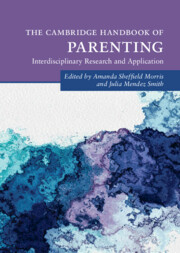Book contents
- The Cambridge Handbook of Parenting
- Cambridge Handbooks in Psychology
- The Cambridge Handbook of Parenting
- Copyright page
- Dedication
- Contents
- Contributors
- Figures
- Tables
- Introduction
- Part I Foundations of Parenting
- Part II Parenting across Development: Social, Emotional, and Cognitive Influences
- Part III Parental Factors That Impact Parenting
- Part IV Child Factors that Impact Parenting
- 17 Parenting Children with Disabilities
- 18 Parenting Children with Externalizing Behavior and ADHD
- 19 Parenting in the Context of Child Anxiety and Depression
- 20 Parenting LGBTQ Children and Adolescents
- 21 Parenting Children with a History of Adversity
- Part V Parent Education, Intervention and Policy
- Index
- References
20 - Parenting LGBTQ Children and Adolescents
from Part IV - Child Factors that Impact Parenting
Published online by Cambridge University Press: 01 December 2022
- The Cambridge Handbook of Parenting
- Cambridge Handbooks in Psychology
- The Cambridge Handbook of Parenting
- Copyright page
- Dedication
- Contents
- Contributors
- Figures
- Tables
- Introduction
- Part I Foundations of Parenting
- Part II Parenting across Development: Social, Emotional, and Cognitive Influences
- Part III Parental Factors That Impact Parenting
- Part IV Child Factors that Impact Parenting
- 17 Parenting Children with Disabilities
- 18 Parenting Children with Externalizing Behavior and ADHD
- 19 Parenting in the Context of Child Anxiety and Depression
- 20 Parenting LGBTQ Children and Adolescents
- 21 Parenting Children with a History of Adversity
- Part V Parent Education, Intervention and Policy
- Index
- References
Summary
Parent-child relationships are extremely important for sexual and gender minoritized youth as they and their families navigate the challenges of “coming out” and living in a highly heteronormative and often homonegative and transnegative society. This chapter presents the current terminology for and demography of LGBTQ youth in the United States; discusses the unique experiences of LGBTQ children and their parents, including child and parent reactions to the coming out process and its reverberations through the family system; reviews the emerging scientific literature on parenting effects on LGBTQ child health and well-being; and considers the implications for policy and clinical practice that support parents of LGBTQ youth in ways that foster nurturance, advocacy, and the health and well-being of both youth and parents.
- Type
- Chapter
- Information
- The Cambridge Handbook of Parenting , pp. 446 - 464Publisher: Cambridge University PressPrint publication year: 2022

